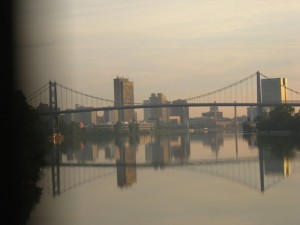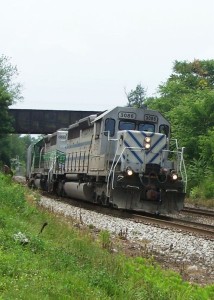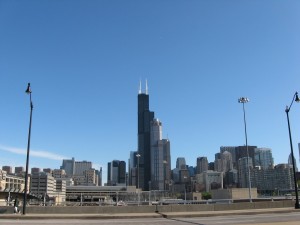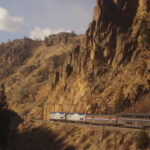Around the U.S. By Train – Part 8
During the night, the Lake Shore Limited crosses up-state New York, a corner of Pennsylvania and heads into Ohio. I raise my window shade to the soft light of dawn. We’re in Toledo and crossing the Maumee River just before it empties into Lake Erie.
 Breakfast in the dining car is enjoyable because I’m seated with a young man who is on his way back to Chicago after helping a friend move to New York City. They attended an inter-league game between the Cubs and White Sox in Chicago, then loaded a rented truck with the friend’s belongings and drove it to New York. After unloading and with no sleep for two-plus days, he bought a coach ticket on the Lake Shore and headed home. He’s bleary-eyed, but after several cups of coffee and with a good breakfast in front of him, we are soon deep into an animated baseball conversation. He is a devoted fan of the White Sox and, since I have a similar devotion to the Bostion Red Sox, we discover a deep common bond: we both have a loathing of the New York Yankees which, we happily agree, borders on the irrational, but is understandable, justifiable and absolutely normal.
Breakfast in the dining car is enjoyable because I’m seated with a young man who is on his way back to Chicago after helping a friend move to New York City. They attended an inter-league game between the Cubs and White Sox in Chicago, then loaded a rented truck with the friend’s belongings and drove it to New York. After unloading and with no sleep for two-plus days, he bought a coach ticket on the Lake Shore and headed home. He’s bleary-eyed, but after several cups of coffee and with a good breakfast in front of him, we are soon deep into an animated baseball conversation. He is a devoted fan of the White Sox and, since I have a similar devotion to the Bostion Red Sox, we discover a deep common bond: we both have a loathing of the New York Yankees which, we happily agree, borders on the irrational, but is understandable, justifiable and absolutely normal.
Outside our dining car window, the landscape has flattened out and we’re passing fields of corn, tidy farm houses and barns, most of them in the traditional Dutch colonial design and painted in the classic red.
 The Lake Shore slows to a crawl and the conductor announces that we have done so to allow a CSX freight train to cross in front of us. Many of these freights are close to 7,000 feet long and can cause real problems when trundling slowly through these small mid-western towns. Of course traffic stalls at intersections waiting for the freights to pass, but the worst case scenario is a fire breaking out on one side of town and the fire equipment having to wait for a slow freight to clear an intersection before being able to respond. Anticipating that, many of these towns have had to duplicate fire and police facilities on each side of the tracks, effectively doubling the cost of equipment and personnel.
The Lake Shore slows to a crawl and the conductor announces that we have done so to allow a CSX freight train to cross in front of us. Many of these freights are close to 7,000 feet long and can cause real problems when trundling slowly through these small mid-western towns. Of course traffic stalls at intersections waiting for the freights to pass, but the worst case scenario is a fire breaking out on one side of town and the fire equipment having to wait for a slow freight to clear an intersection before being able to respond. Anticipating that, many of these towns have had to duplicate fire and police facilities on each side of the tracks, effectively doubling the cost of equipment and personnel.
There’s nothing fancy about these little towns. Most have a main street lined with small shops and stores, with houses on the nearby streets modest in size and of simple, utilitarian design – all a reflection of mid-western values and tastes.
Just past Waterloo, Indiana, we pass several huge piles of wooden railroad ties, evidence of the extensive track work being done all along this route.
 The Lake Shore rattles along now at a steady pace while outside the houses come more frequently and begin to blend into light industrial areas. Soon, well up ahead but rising well above the other buildings on the skyline is the distinctive profile of the Sears Tower. Chicago is dead ahead.
The Lake Shore rattles along now at a steady pace while outside the houses come more frequently and begin to blend into light industrial areas. Soon, well up ahead but rising well above the other buildings on the skyline is the distinctive profile of the Sears Tower. Chicago is dead ahead.




Yes, freight railways cause huge delays. They made a formal written commitment to give passenger trains priority, but routinely break that promise. With no consequences.
I could rail about the lack of integrity and low moral and ethical standards of people who routinely violate their solomn vows and promises. But I’ve got a better idea.
For every one minute that an Amtrak train is late, the host freight railway company owes each passenger a 1% refund on their ticket. Five minutes late means a 5% refund. Ten minutes late means a 10% refund. And an hour and 40 minutes late means a 100% refund, paid for by the freight railway.
I predict that such a system would suddenly result in the trains running on time. To the exact minute.
Hence the nickname “Late Shore Limited.” Of course we all realize that most of the delays are caused by CSX and are not Amtrak’s fault. Apparently things have improved somewhatin recent months. For example, for the past week, arrival in Chicago has averaged 25 minutes late. This link is handy and interesting: http://www.amtrakdelays.com/
I forgot to mention that the return timetable from Chicago to Buffalo had the train leaving Chicago at 9:30 PM and arriving in Buffalo at 7:30 AM.
Again, a business-friendly schedule that ensured we got to morning meetings in Toronto on time.
I just looked at the timetable on Amtrak’s website and it is now scheduled to leave Chicago at
10:00 PM and arrive in Buffalo at 9:30 AM. And for the last year its on-time rate was 61.1%.
A business-hostile arrival time and unreliable.
When I was a consultant I would frequently take this train when I had to travel from Toronto to Chicago, boarding it in Buffalo.
It had an incredibly convenient timetable. I would board it in Buffalo at 11:30 PM and it would arrive in downtown Chicago the next morning at 8:30 AM.
For consultants, every hour spent in travel time is a dead waste. This train essentially had zero travel time. I would get on board, go straight to my sleeper car and go to sleep. I would wake up 8 hours later at 7:30 AM, take a shower on board the train, get dressed and be finishing breakfast in the dining car just as it pulled into the station in downtown Chicago.
All those things – sleeping, showering and eating – I would have had to do anyway. So zero extra time was taken by travel. Needless to say, there was a lot of business travel on that train. Saving those travel hours was golden.
Then the train became totally unreliable. We all know just exactly how and why that happened!
It could no longer be 100% certain that the train would arrive it Chicago at 8:30 AM. Businessmen started missing meetings. So (no surprise!) they stopped using it.
As a US citizen I’m registered as an absentee voter in the great state of Wisconsin. Needless to say, this fall I’m not voting for the gang of politicians who deliberately destroyed business rail travel in pursuit of their bizarre ideology.
Jim, our son told us about Giordano’s. They have several Chicago locations including one about three or four blocks from Union Station. HIGHLY recommend it next time you’re in the Windy City!
It is a nice ride, altho have not idea about the pizza.
Jim, you raised an interesting point about the small towns along the route. I would not have thought about having to provide duplicate emergency services on both sides of the track. We saw a lot of small towns in VA, NC and SC while riding the Palmetto a few months ago. Some continue to thrive but all too many are pretty clearly dying – small factories and stores boarded up, homes in disrepair.
Sounds like you had a pretty good ride to Chicago, though. Is it true that Giordano’s is the Official Pizza of Chicago Amtrak?